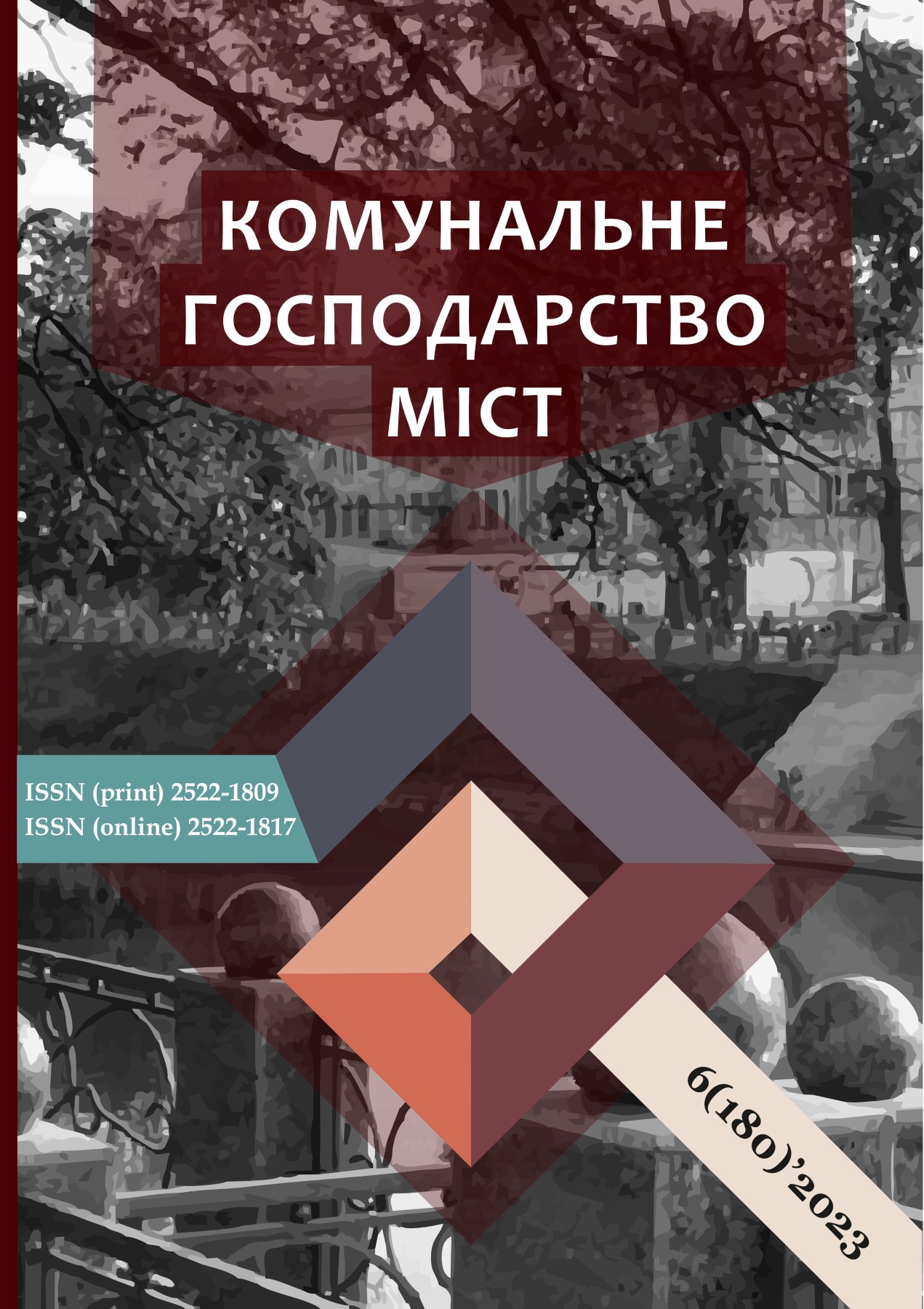ДОСЛІДЖЕННЯ ЗНИЖЕННЯ МІЦНОСТІ БЕТОНУ ЗАЛІЗОБЕТОННОГО РИГЕЛЯ В УМОВАХ ВОГНЕВИХ ВИПРОБУВАНЬ
DOI:
https://doi.org/10.33042/2522-1809-2023-6-180-176-186Ключові слова:
залізобетонний ригель, вогневі випробування, коефіцієнт зниження міцності бетону, вогнестійкістьАнотація
У статті викладені результати досліджень змінення міцності бетону залізобетонного ригеля залежно від температури шляхом інтерпретації даних вогневих випробувань. Дані, необхідні для дослідження зниження міцності бетону залізобетонного ригеля, були отримані шляхом вогневих випробувань. За цими даними було одержано закономірність зміни міцності бетону у залежності від температури і показана адекватність отриманих результатів.
Посилання
Liu, C., Zhou, B., Guo, X., Liu, C., & Wang, L. (2023). Analysis and prediction methods for the static properties of reinforced concrete beams under fire. Structures, 47, 2319–2330. DOI: 10.1016/j.istruc.2022.12.041
Pozdieiev, S. V. (2012). Development of scientific basis for determining fire resistance limits of load-bearing reinforced concrete structures [Doctoral dissertation]. National University of Civil Protection of Ukraine [in Ukrainian]
Kodur, V., & Banerji, S. (2020). Comparative fire behavior of reinforced concrete beams made of different concrete strengths. Proceedings of the 11th International Conference on Structures in Fire (SiF2020), (pp. 254–261). The University of Queensland. DOI: 10.14264/bd10594
Phan, L. T., McAllister, T. P., Gross, J. L., & Hurley M. J. (Eds.). (2010). Best Practice Guidelines for Structural Fire Resistance Design of Concrete and Steel Buildings. NIST Technical Note 1681. National Institute of Standards and Technology. Retrieved from https://nvlpubs.nist.gov/nistpubs/technicalnotes/nist.tn.1681.pdf
Johnson, R. P., & Wang, Y. C. (2018). Composite Structures of Steel and Concrete: Beams, Slabs, Columns and Frames for Buildings. Wiley-Blackwell.
England, J. P., Young, S. A., Hui, M. C., & Kurban, N. (2000). Guide for the Design of Fire Resistant Barriers and Structures. Building Control Commission.
De Souza, R. C. S., Andreini, M., La Mendola, S., Zehfuß, J., & Knaust, C. (2019). Probabilistic thermo-mechanical finite element analysis for the fire resistance of reinforced concrete structures. Fire Safety Journal, 104, 22–33. DOI: 10.1016/j.firesaf.2018.12.005
Shchipets, S. D. (2014). Method for determining the temperature pattern in the cross section of the load-bearing wall as a result of their fire test. Scientific Bulletin of the Ukrainian Research Institute of Fire Safety, 1(29), 79–84. Retrieved from http://nbuv.gov.ua/UJRN/Nvundipb_2014_1_14 [in Ukrainian]
Lie, T. T. (2002). Fire Temperature-Time Relations. In P. J. DiNenno, D. Drysdale, C. L. Beyler, W. D. Walton, R. L. P. Custer, J. R. Hall, & J. M. Watts (Eds.), SFPE Hand-book of Fire Protection Engineering (3rd ed., pp. 4–201–4–208). National Fire Protection Association. Retrieved from https://rakandotcom.files.wordpress.com/2016/05/sfpe.pdf
Pozdieiev, S. V., Otrosh, Yu. A., Omelchenko, A. M., Shchipets, S. D., & Kropyva, M. O. (2014). Interpretation of the results of fire tests of reinforced concrete beams to assess their fire resistance limit. Promyslove budivnytstvo ta inzhenerni sporudy, (2), 14–18. Retrieved from https://urdisc.com.ua/rl/info/2_14.pdf#page=14 [in Ukrainian]
Shnal, T., Pozdieiev, S., Nuianzin, O., & Sidnei, S. (2020). Improvement of the Assessment Method for Fire Resistance of Steel Structures in the Temperature Regime of Fire under Realistic Conditions. Materials Science Forum, 1006, 107–116. DOI: 10.4028/www.scientific.net/MSF.1006.107
Kovalyshyn, V., Pozdieiev, S., & Fedchenko, S. (2018). Concrete walls conduct under the fire influence investigation using final elements method. Emergency Situations: Prevention and Liquidation, (4), 89–98. Retrieved from https://sci.ldubgd.edu.ua/jspui/handle/123456789/6482
Wickström, U., & Pålsson, J. (1999). A Scheme for Verification of Computer Codes for Calculating Temperature in Fire Exposed Structures. SP Report1999:36. SP Swedish National Testing and Research Institute. Retrieved from https://www.diva-portal.org/smash/get/diva2:962108/FULLTEXT01.pdf
Lawson, R. M., Oshatogbe, D., & Newman, G. M. (2006). Design of Fabsec Cellular Beams in Non-Composite and Composite Applications (for Both Normal Temperature and Fire Engineering Conditions). Fabsec Limited.
##submission.downloads##
Опубліковано
Як цитувати
Номер
Розділ
Ліцензія
Автори, які публікуються у цьому збірнику, погоджуються з наступними умовами:
- Автори залишають за собою право на авторство своєї роботи та передають журналу право першої публікації цієї роботи на умовах ліцензії CC BY-NC-ND 4.0 (із Зазначенням Авторства – Некомерційна – Без Похідних 4.0 Міжнародна), котра дозволяє іншим особам вільно розповсюджувати опубліковану роботу з обов'язковим посиланням на авторів оригінальної роботи та першу публікацію роботи у цьому журналі.
- Автори мають право укладати самостійні додаткові угоди щодо неексклюзивного розповсюдження роботи у тому вигляді, в якому вона була опублікована цим журналом (наприклад, розміщувати роботу в електронному сховищі установи або публікувати у складі монографії), за умови збереження посилання на першу публікацію роботи у цьому журналі.
- Політика журналу дозволяє і заохочує розміщення авторами в мережі Інтернет (наприклад, у сховищах установ або на особистих веб-сайтах) рукопису роботи, як до подання цього рукопису до редакції, так і під час його редакційного опрацювання, оскільки це сприяє виникненню продуктивної наукової дискусії та позитивно позначається на оперативності та динаміці цитування опублікованої роботи (див. The Effect of Open Access).

